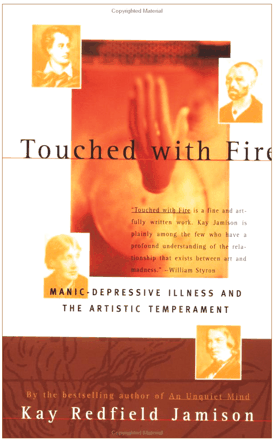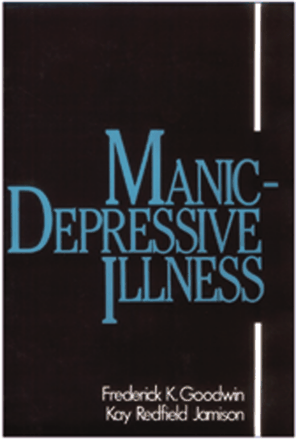The Personal and Professional: Of One Mind
Kay Jamison is as well known beyond the biomedical community as she is within it. Her best-selling memoir, An Unquiet Mind, captivated the general public with its autobiographical account of a young psychiatry professor who found herself severely afflicted by manic-depressive illness. The publication of the book, describing the intersection between her personal and professional identities, marked Jamison’s decision to give up clinical practice. At the same time, she acknowledges, she became freer to write and speak about the disease and to realize her perspectives in patient advocacy. It is thus easy to forget that Kay Jamison is foremost an academician, Professor of Psychiatry at Johns Hopkins, Honorary Professor of English at the University of St. Andrews in Scotland, genomics adviser and researcher. She and coauthor Fred Goodwin are currently working on the second edition of Manic-Depressive Illness, the definitive textbook of the disease for medical professionals. Jamison is also finishing up a book that analyzes the contribution of mood—specifically, of exuberance—to the work of historical and contemporary scientists, to be published in 2004 by Knopf.
MI: Were you attracted to the study of moods when you began your career?
KJ: No, I would say I was more interested in experimental psychology—the mathematical side of psychology. When I was an undergraduate, I had planned on becoming a doctor—not in psychiatric care, by any stretch. And I always planned to be an academic, but at some point I found psychology much more interesting than medicine. I became a research assistant to a psychopharmacologist. I also spent a year abroad at the University of St. Andrews in Scotland studying neurophysiology and zoology. So, I was always studying more the biological side of things.
MI: And so you decided to go to graduate school in psychology at UCLA. It was during graduate school that you changed to an interest in moods?
KJ: I changed to an interest in clinical psychology, but only after I had already done probably two years of graduate school. Up until then, I did statistics and experimental psychology. But then I studied at the University of London for three months, and it became clear I was more interested in the questions that clinical psychology asked—questions of temperament and psychopathology. These questions were riveting; I was just intrinsically interested in the borderlines between normal states and aberrant states, between differing mental states.
MI: You had an interest in psychopharmacology, which seems an interesting link between behavior and the organic, molecular underpinnings of the brain. When you were starting, were those seen as separate spheres?
KJ: Probably more so than they are now. But when I was studying neurophysiology, those distinctions weren’t made; one was certainly able to study psychopathology without having any sense of neuroanatomy or neuropsychology as we now know it.
MI: How has the relationship between neurochemistry and psychiatric disorders changed since you began your career?
KJ: Well, it’s changed hugely in terms of knowledge. When I was a student, you started to learn about synapses and evoked potentials, and neuropharmacology was a concept, certainly, but it was just primitive compared to what we have now. There was no such thing as neuroimaging, there was no such thing as neurogenetics. The weight of increasing knowledge is staggering.
MI: One of the first things you did after you graduated and joined the faculty, also at UCLA, was to start a mood disorder clinic. Was manic-depressive illness something you were interested in specifically at that point?
KJ: Well, I had no interest in manic-depressive illness before I had my first manic break. I mean, I had studied psychopathology, and manic depression was interesting to me in a general, literary sense, but I didn’t know that I suffered from it. And most of the emphasis on psychopathology in graduate school and in my undergraduate studies had been in schizophrenia. Bipolar illness is a much more recently emphasized subject. When I got my PhD and first became a faculty member, I went totally manic, and as soon as I got over my manic episode and kind of recovered from that, I completely changed my research emphasis, and my clinical teaching emphasis changed. Everything in my career turned a complete 180. I just decided I was going to do everything I could to learn about it.
MI: So you had to train yourself as well as getting ready to train students in the clinic?
KJ: Yes. Running a clinic at a university hospital means not only that you’re going to run a clinical program, but that you’re also doing the teaching program and the research program. Of the two people with whom I set up the clinic, one had trained at the NIH and was quite familiar with the research on manic depression, and the other was a child psychiatrist with a lot of research and clinical experience. And it’s like everything else in life—when you’re motivated, you learn very fast. I read everything I could. I started a series of research protocols—my medical director and I did. And ours was one of the first mood disorder clinics on the West Coast. There’s so much of an emphasis on bipolar now, but it’s hard to say how little was being done at that time outside the NIH and a few other places.
MI: Was manic depression seen as a treatable disease when you were starting the clinic?
KJ: Lithium had only been approved by the FDA for three years when we started the clinic in 1977. So, manic depression was regarded as a very serious illness with not necessarily a very good prognosis. There was just not as nearly as much known as there is now, and we got a lot of very sick people. But we also saw many people who responded very well to treatment, particularly with lithium.
MI: Beyond lithium, what can treatment of manic-depressive illness involve?
KJ: There are probably eight or nine anticonvulsive medications, such as Depakote and Tegretol, that are now used for bipolar illness. Antidepressants are used, somewhat more problematically, and then there are the atypical antipsychotic drugs, but lithium is still kind of the standard. And in terms of psychotherapy, whereas thirty years ago it would have been psychoanalysis or insight therapy, there are now more structured psychotherapies, like cognitive and behavioral therapy.
MI: What was it like to be setting up a mood disorder clinic at the same time that you were realizing that you had manic-depressive illness?
KJ: Well, it was difficult, because my illness was very hard. And I found it necessary to keep a distance. You don’t do anybody any good by being subjective. There’s always a danger of overgeneralizing from your own experiences, and I’ve tried very hard on my own and in my own psychotherapy to keep things in perspective.
MI: Were there ways that having the illness helped your professional life?
KJ: Well, it certainly has had the net effect of making my research more important to me than it perhaps otherwise would have been, and it focused my research questions for sure. And it has driven my advocacy and my teaching. I’ve focused on issues like suicide and on the positive psychological aspects of the illness. I’m probably more aware of those aspects than someone who doesn’t have the illness. I mean, I really know, inside and out, that it’s a lethal disease. I’ve nearly died from it. And when you nearly die from something, you take it very, very seriously, and it permeates everything that you do. So, I’m probably more passionate and more impatient than most people about the rate of progress. But a lot of my colleagues are impatient to get answers, which I think is a great thing about science—scientists are impatient by temperament. One of the reasons that so much good science gets done is that there are a lot of impatient people around that don’t just sit around and watch the grass grow.
MI: Was the lethality of mood disorders taken seriously when you were entering the field?
KJ: Well, I think people tended to think of suicide as a field separate from mood disorders. It was known that people with mood disorders were at a high risk of suicide, but it was not nearly as much emphasized as it is now that those two are much more folded into one another. There was a huge suicide movement in this country that was very psychologically oriented and that didn’t believe in the medical model and didn’t believe, for example, that manic depression as an illness was biologically based. The lethality of mental illness has never been seen in the same way as the lethality of cancer, for example.
MI: And your advocacy work aims in part to make the mortality rate associated with mental illness more apparent?
KJ: Right. You know, the AIDS advocates always had that very clear focus: From square one, they saw people dying, and they really made that part of their advocacy. They would not allow the community to forget that people die from this illness. And I think that focus is something that our field does not have. There’s a pretty high death rate associated with mood disorders.
MI: Do clinicians frequently take on the role of being advocates?
KJ: A lot of scientists and people in psychiatry have done so. My husband—my late husband, Richard Wyatt, who was Chief of Neuropsychiatry at the NIMH and a schizophrenia researcher—was involved in advocacy, in giving public lectures and in ask-a-doctor programs where people call in and ask about drugs and treatment. And a lot of research doctors are involved in advocating public awareness.
MI: And why is it important to make the public aware?
KJ: Because people die from these illnesses. Because these are treatable illnesses. And partly to encourage people to put demands on their doctors, to know what they’re talking about when they ask their doctors questions, and to get second opinions. And there is still huge stigma attached to mental illness. From AIDS advocacy groups we’ve seen the effectiveness of unification by dint of identifying themselves as voters. AIDS advocates make it very clear to politicians that they vote, and because they’re a significant percentage of the population, they can swing an election, and they can raise a lot of money. In the mental illness community, people don’t think of themselves as voters. And I think that’s a real key to having power.
MI: What are some of the problems that the mentally ill face in terms of health care?
KJ: First of all, there’s no pretense of parity. If you’re an insurance company and you give insurance coverage for every other disease, you’re not required to cover mental illness in the same way. This is outrageous. It is barbaric. It’s unforgivable. So I can get up and talk in front of other people and say, “Go see a doctor!” and so forth, but people may simply not be able to afford it.
MI: Is it just cost? Is that where the resistance to insuring mental illness comes from?
KJ: Well, it is unclear that the cost would be especially high, because people treated for mental illness tend to use the rest of the medical system much less. And treatment for mental illness is a lot less expensive than the social costs of alcohol and drug abuse and lost days of work. Depression is the greatest cause of disability in the world.
MI: You talk about the difference between perspectives on “medical” diseases and those on mood disorders. Does that schism still pervade?
KJ: It does. Not as much as it did—things have certainly changed. But it is still there to a large extent.
MI: What has helped people to accept the idea that mood disorders are truly “medical” in nature?
KJ: I think for example of neuroimaging, where people can actually see that there’s an organ involved, that there’s a brain involved. I think that journalism by and large has been excellent. I think a lot of journalists themselves have depression. I think that when the SSRIs came out, like Prozac, one of the reasons that they got such publicity was that the individual journalists took these drugs and they worked! And they increased the focus on the biological side of these illnesses. When I wrote An Unquiet Mind, I had hundreds and hundreds of interviews—nonstop television, radio and print interviews—and I heard journalists talking about family members and themselves. Another very strong influence, obviously, is the pharmaceutical industry, because they have every financial motivation in the world to educate the public, which they do.
MI: Why should neuroimaging have an impact on the perception of mental illnesses? After all, we already knew that the brain is there and that brains control mood...
KJ: I don’t think we did know that the brain was there. I mean, I think if you ask people what the brain does, they would think of memory and learning and cognition. They wouldn’t think of moods and emotions that much. There’s an intuitive gap. If you say “lung cancer,” you think, “lungs,” right? Outside of advocacy groups, I don’t think that the general public thinks about brain diseases, and if they do, they think about stroke or epilepsy. They don’t think of schizophrenia, depression, panic disorder, or manic depression.
MI: So, neuroimaging gives people a visual image that links mental disorders to the brain?
KJ: Right. And genetics. The emphasis on the human genome project and the identification of genes for schizophrenia, etc., is beginning to drop into the collective unconscious. But it isn’t obvious, at all.
MI: Maybe scientists understand the link between brain and mental illness, but...
KJ: It isn’t even obvious to scientists, in a way. It’s obvious to doctors, maybe. Internists take depression seriously now because they realize it leads to heart disease if it goes untreated. And they’re getting more and more patients in their practices who ask, “Do you think I could be depressed?” There’s been a real campaign to educate internists and GPs and pediatricians about asking about depression. But that’s only very recent.
MI: Within the context of manic-depressive illness, there are some very interesting moral issues in genomics. Do you want to talk about that?
KJ: Well, I think manic-depressive illness is extremely complicated, involving positive as well as negative aspects in genetic analysis. I think the potential positives of genomic research are largely obvious: earlier recognition and more accurate diagnosis. What we regard as manic depression is most certainly a group of diseases. So what you want to know, obviously as quickly as possible, is what kind of drug or intervention a particular type of illness is going to respond to—you don’t want to give someone a drug if there’s no chance that they’re going to respond to it. There’s a tremendous amount to be learned from genetics, not only about manic depression but about moods, the regulation of moods, the regulation of intellect, behavior, energy, and sleep. All of these aspects play roles in this hugely complicated illness. Better genetic data will lead to more specific diagnoses, more specific treatments.
MI: When you as a clinician have looked at patients with manic depression, was there a sense that individuals fit into certain subtypes of disease?
KJ: Sure. Some patients spend much more of their lives, temperamentally and in terms of their illness, being depressive, whereas others are much more outgoing, full of energy, full of exuberance, full of joie de vivre, who happen to tip over into mania every now and again. There are differences in how rapidly people cycle through moods. There is a very diverse set of temperaments with a lot of plasticity. In Touched with Fire, I wrote about the aspects of hyperacuity and the fiery responses of artists to environmental stimuli, and about the positive aspects of imagination, risk taking, and impulsiveness. You know, it’s not to romanticize a bad disease, but it’s complicated. The question arises, “Would you want to get rid of these temperaments?” I don’t think so. Do you want to get rid of the illness? Yes, but you also have to think about the trade-offs between illness and these positive aspects of temperament. And I think the jury’s out on this.
MI: Is there anything to fear about the genomics revolution as it relates to mental illness?
KJ: There’s always a fear of the unknown, which can be a legitimate fear. We don’t know, for example, what premium society is going to put on the cost of disease. Psychiatric diseases are notoriously costly, in economic terms. This was an argument that Hitler used, and the very first people to be killed under Hitler were the mentally ill. He had is own doctors kill the mentally ill because they were costly, and he had economic posters up on the walls of the asylums to support his argument. Now, this is not to suggest that that is ever going to happen again, but there are more subtle notions of it. In China, there is forced sterilization if you have a hereditary psychosis. What are the hereditary psychoses? Schizophrenia and manic depression. Does this seem to bother very many people? It doesn’t seem to. But that’s the most populous country in the world! You’re talking about a minority, but this is a huge social experiment.
We did a study that asked patients and their spouses whether they would, in order to get rid of the genes for manic depression, abort a fetus. And the answer is always overwhelmingly no, by both spouses and patients. But the response changes if you ask about the more severe forms of mental illness. So, who knows? I have a lot of concerns about these issues. I have moral concerns about being able to intervene in people’s moods, which is an obvious direction to apply genetic knowledge. I mean, if you could make everyone exuberant, or hypomanic, what would be the consequences? The potential for addiction would be huge. The potential for abuse would be huge. The potential for being damaging to society would be huge. Fortunately, I basically have faith that there are enough rebellious people around who are not going to want to get rid of these genes, because they don’t want to get rid of themselves—and that people will end up on the side of diversity. I hope so.
- © American Society for Pharmacology and Experimental Theraputics 2003








